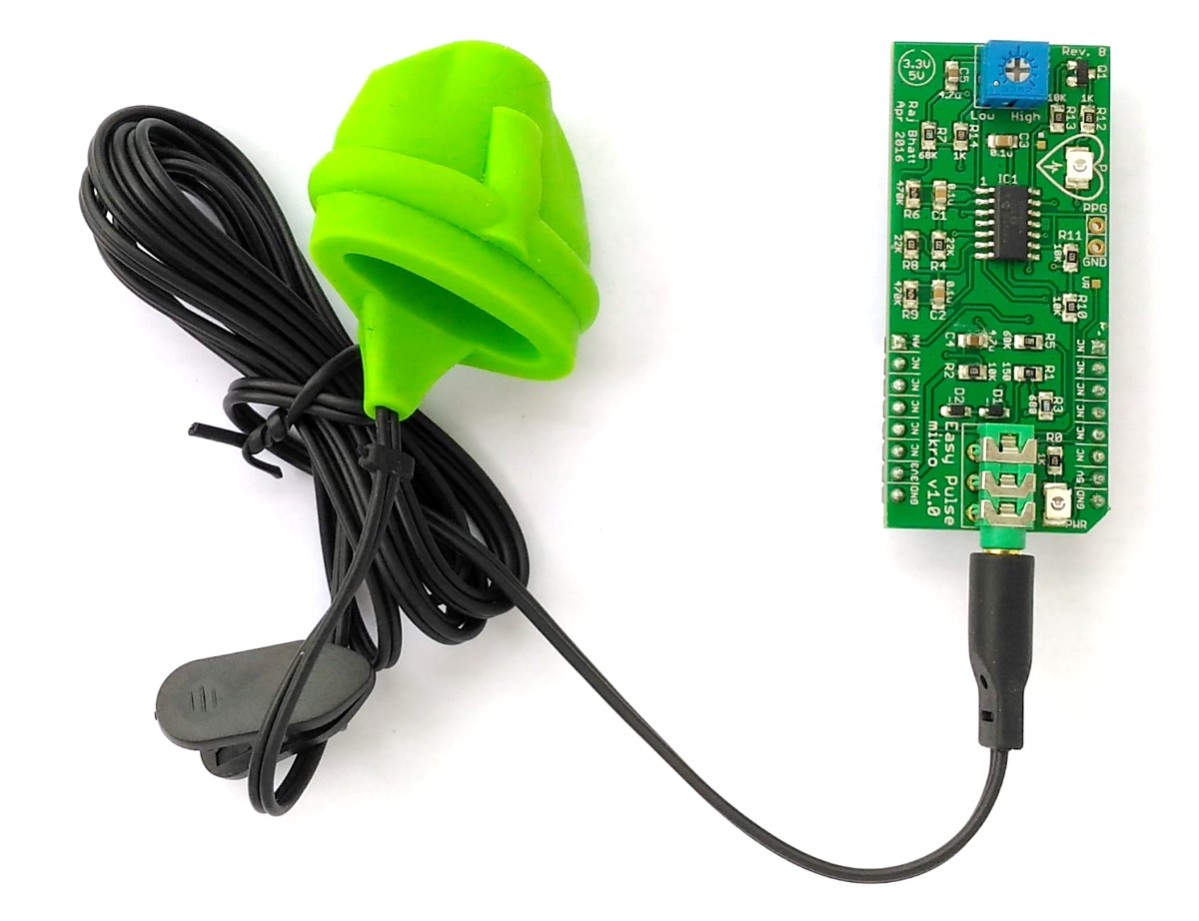








Easy Pulse mikro (ER-CDE17527M) incl. Transmittance PPG pulse sensor
In medicine, the number of times the heart beats within a certain time period, usually a minute. The pulse can be felt at the wrist, side of the neck, back of the knees, top of the foot, groin, and other places in the body where an artery is close to the skin.
₹ 750 ₹999
999



| Made In : | India |
Add FAQ
A heartbeat sensor is designed to detect and measure heartbeats, often using optical or electrical methods. These sensors are commonly used in health monitoring, fitness tracking, and medical diagnostics. They provide real-time feedback on heart rate and can be integrated into various wearable devices or monitoring systems.
Key Features:
-
Heartbeat Measurement:
- Heart Rate Detection: Measures the number of heartbeats per minute (bpm) by detecting changes in blood flow or electrical activity associated with heartbeats.
- Real-time Monitoring: Provides immediate feedback on heart rate, useful for tracking cardiovascular health and fitness levels.
-
Detection Methods:
- Optical Sensors (Photoplethysmography - PPG):
- How It Works: Uses light to measure changes in blood volume in the skin. A light source (LED) shines through the skin, and a photodetector measures the amount of light reflected or transmitted. Variations in light absorption correlate with changes in blood volume, allowing the sensor to calculate heart rate.
- Electrical Sensors (Electrocardiography - ECG):
- How It Works: Measures the electrical activity of the heart. Electrodes placed on the skin detect electrical signals generated by heartbeats. These signals are then processed to determine heart rate and other cardiac information.
- Optical Sensors (Photoplethysmography - PPG):
-
Power Supply:
- Low Power Consumption: Designed to operate with minimal power, making them suitable for battery-operated devices.
-
Data Output:
- Analog Output: Provides a continuous voltage signal representing the heartbeat waveform.
- Digital Output: Provides heart rate data in beats per minute (bpm), often after processing the raw signal.
-
Compatibility:
- Microcontroller Interface: Commonly interfaces with microcontrollers like Arduino, Raspberry Pi, and other development boards for processing and displaying heartbeat data.
-
Applications:
- Fitness Tracking: Used in fitness trackers and smartwatches to monitor heart rate during exercise and daily activities.
- Medical Monitoring: Utilized in medical devices to monitor patients’ heart rates and detect abnormalities.
- Health and Wellness Apps: Integrated into health apps for tracking and analyzing heart rate data.
Example Connection with Arduino:
To connect and use a heartbeat sensor with an Arduino, follow these steps. Here’s an example using an optical pulse sensor, which is a common type of heartbeat sensor.
Wiring Instructions:
- Heartbeat Sensor to Arduino:
- VCC (Heartbeat Sensor) to 5V (Arduino) (or 3.3V depending on the sensor specifications).
- GND (Heartbeat Sensor) to GND (Arduino).
- SIGNAL (Heartbeat Sensor) to an analog input pin on the Arduino (e.g., A0).
// Pin configuration
const int pulsePin = A0; // Analog pin where sensor output is connected
int sensorValue = 0; // Variable to store the sensor reading
// Variables for pulse counting and time
unsigned long lastMillis = 0; // Last time the pulse was calculated
unsigned long pulseInterval = 1000; // Interval to check pulse in milliseconds (1 second)
int pulseCount = 0; // Number of pulses detected
// Variables for pulse detection
int threshold = 512; // Threshold value for detecting pulse peaks
int lastSensorValue = 0; // Last sensor reading to detect peak change
// Heart rate calculation variables
float heartRate = 0.0; // Heart rate in beats per minute (BPM)
void setup() {
Serial.begin(9600); // Start serial communication at 9600 baud rate
pinMode(pulsePin, INPUT); // Set the pulse sensor pin as input
}
void loop() {
// Read sensor value from the analog input pin
sensorValue = analogRead(pulsePin);
// Simple peak detection: If the current sensor value crosses the threshold and is higher than the last value
if (sensorValue > threshold && lastSensorValue <= threshold) {
// A peak (pulse) is detected
pulseCount++;
lastMillis = millis(); // Update time of the last detected pulse
}
// Update last sensor value
lastSensorValue = sensorValue;
// Calculate and display the heart rate every 1 second (1000 milliseconds)
if (millis() - lastMillis >= pulseInterval) {
if (pulseCount > 0) {
// Calculate heart rate (beats per minute) based on the number of pulses detected in the last 1 second
heartRate = pulseCount * 60.0 / (pulseInterval / 1000.0); // Convert to BPM
} else {
heartRate = 0.0;
}
// Print the heart rate value to the Serial Monitor
Serial.print("Heart Rate: ");
Serial.print(heartRate);
Serial.println(" BPM");
// Reset pulse count for the next measurement period
pulseCount = 0;
}
}
0 Reviews For this Product












.jpg&width=225&quality=80)
